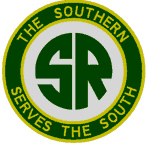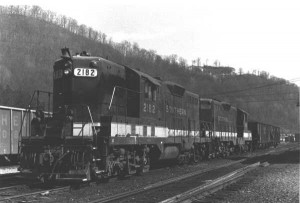- Size: 20′ x 15′
- Scale: HO
- Minimum Mainline Radius: 27″
- Minimum Aisle Width: 26″
- Designed by Dan Bourque
![]() The Interstate Railroad built the Dixiana Branch in 1954 on top of an old narrow-gauge right-of-way from Addington (Holton), VA to Dixiana. At the end of the long branch was a five-track tipple that was transplanted from another coal mine far away. Along the branch, smaller loaders popped up at various sidings and spurs making this a busy branch served by two mines per day after the Southern took over operations in 1965.
The Interstate Railroad built the Dixiana Branch in 1954 on top of an old narrow-gauge right-of-way from Addington (Holton), VA to Dixiana. At the end of the long branch was a five-track tipple that was transplanted from another coal mine far away. Along the branch, smaller loaders popped up at various sidings and spurs making this a busy branch served by two mines per day after the Southern took over operations in 1965.
The Layout
This layout depicts the Dixiana Branch as it appeared in the 1970s. An earlier era would merely entail removing the Camp Creek loader and Austin Powder. There were two branches that left the wye at Holton, but in this plan, the Glamorgan Branch is represented by a single staging track. On the other leg of the wye is the track down to staging which could represent either Norton, VA (the nearest yard) or Andover, VA (the origin of all Interstate and Southern mine runs for the branch). Staging is designed as a three- or four-track reversing loop under Dixiana. There’s room for 20′ long staging tracks which would allow for trains of around 40 cars which is good because the modeled mines have a capacity of about 50 cars plus another 20 in Glamorgan staging.
All four coal loaders on the line are modeled along with Austin Powder and Holton on the Glamorgan line. The loader at Camp Creek was flipped to the other side of the main to put it toward the back of the scenery instead of the front. The distance between Holton and Dixiana is SIGNIFICANTLY compressed, but this is mitigated somewhat by dividing the two scenes and having trains pass through a hidden area along the wall before reappearing. Grades are steep throughout but within the norms for this area, so some sort of braking mechanism would need to be used at some of the loaders. This layout would only require a handful of locomotives, so an entry DCC system with a booster and walk-around throttles would be sufficient.
Operations
This layout could easily keep a pair of operators busy for 2-3 hours. Trains on this layout would be long, so two-person crews would definitely help with the switching. In the Interstate era, this area was served by a single mine run called the “East Switcher.” To run an Interstate-era session, the ammonium nitrate storage bins for Austin Powder and the Camp Creek loader could be removed. Despite the long train, Interstate mine runs worked with a single RS3. The mine run would start in Andover staging and work it’s way up the branch, dropping empties on the way up and collecting loads on the return trip. Dixiana billed loads to various railroads, so before leaving, crews would be on the radio with the dispatcher telling them where each load was going, and the crew would block the train before leaving Dixiana–this would add some additional (and prototypical) operation for the mine run crew. Loads for Glamorgan could be staged, and the mine run would need to drop empties at Holton to begin the shift and swap them out for loads before heading back to Andover.
 In the Southern era, the coal boom necessitated two mine runs a day, but each mine run worked different loaders on the same line. Standard power in the late 1960s was a pair of F-units or an F and a GP7. In the early 1970s, it was GP38s, and in the mid to late ’70s, other geeps like GP30s joined the 38s. The Southern’s 1st Mine Run worked the tipples shipping to other railroads using “standard” (70T or 100T) hoppers. The 3rd Mine Run worked the tipples loading “yellow balls,” the nickname for the old beat up 50T hoppers (later 70T) in shuttle service to the huge coal transloader in Appalachia, VA, adjacent to Andover. In the Southern era, Holton, Glamorgan, and Critical Fork normally loaded standard hoppers, Camp Creek loaded “yellow balls,” and Dixiana 1 and 2 loaded a mix depending on the week. In addition to the variety of hopper types, 3-4 covered hoppers (mainly Seaboard, ACL and SCL cars) would be spotted at Austin Powder along with the occasional boxcar, flatcar or tank car for the larger mine operations at Dixiana and Glamorgan. For the occasional session, a third train could be staged to represent a “Hill Crew” being called upon to spot a few cars at Holton when the coal boom was in full swing.
In the Southern era, the coal boom necessitated two mine runs a day, but each mine run worked different loaders on the same line. Standard power in the late 1960s was a pair of F-units or an F and a GP7. In the early 1970s, it was GP38s, and in the mid to late ’70s, other geeps like GP30s joined the 38s. The Southern’s 1st Mine Run worked the tipples shipping to other railroads using “standard” (70T or 100T) hoppers. The 3rd Mine Run worked the tipples loading “yellow balls,” the nickname for the old beat up 50T hoppers (later 70T) in shuttle service to the huge coal transloader in Appalachia, VA, adjacent to Andover. In the Southern era, Holton, Glamorgan, and Critical Fork normally loaded standard hoppers, Camp Creek loaded “yellow balls,” and Dixiana 1 and 2 loaded a mix depending on the week. In addition to the variety of hopper types, 3-4 covered hoppers (mainly Seaboard, ACL and SCL cars) would be spotted at Austin Powder along with the occasional boxcar, flatcar or tank car for the larger mine operations at Dixiana and Glamorgan. For the occasional session, a third train could be staged to represent a “Hill Crew” being called upon to spot a few cars at Holton when the coal boom was in full swing.
Things I Like About this Plan:
- Lots of loaders
- Allows fairly prototypical operations
- Long staging tracks and reversing loop
- Straightforward with little hidden trackage
- Ability to run multiple eras with significant changes in motive power and hoppers
Things I Don’t Like About this Plan:
- Very compressed between Holton and Dixiana
- Some compromises on track arrangements (Camp Creek flipped, two tracks at Dixiana stubbed)
- One narrow aisle pinch point where a bar juts out from under Critical Fork.
Related Products:





